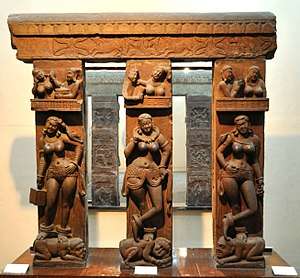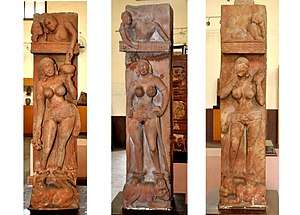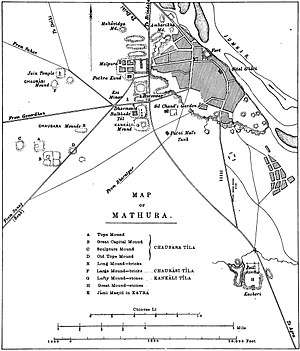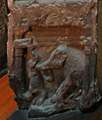Bhutesvara Yakshis
| Bhutesvara Yakshis | |
|---|---|
 Bhutesvara Yakshis, Mathura, 2nd century CE. The Buddhist reliefs of the back of the pillars are visible in the mirror behind. Indian Museum, Kolkata.  The Bhutesvara Yashis in the Mathura Museum. | |
| Material | Red sandstone |
| Period/culture | 2nd Century CE |
| Discovered | 27°36′00″N 77°39′00″E |
| Place | Mathura, India. |
| Present location | Indian Museum, Kolkata, India. Also Mathura Museum, Mathura |
The Bhutesvara Yakshis, also called the Bhutesar Yakshis are a series of Yakshi reliefs on railing, dating to the 2nd century CE during the time of the Kushan Empire.[1] The reliefs were found in the Bhutesar mound, around the remains of a stupa, near Mathura, and are now located in the Indian Museum in Kolkata.[2] They are an important example of Mathura art. Three more pillars and one fragment (half of a pillar) from this group are visible in the Mathura Museum.
Front of the pillars
The Yakshis are seen standing above crouching figures of dwarves.[3] This group of Yakshi figures is praised for the delicacy of their rendering, the absence of heaviness despite the plumpness of the figures, and their smiling and playful countenance.[2]
The Yashis have varied attitudes. One of them is seen holding a bird cage. Another one looks at herself in a mirror while adjusting a piece of earring. Yet another serves wine to the couple above and holds a grape of wine.
 The Yakshis as discovered by Alexander Cunningham in 1881-1882.[4]
The Yakshis as discovered by Alexander Cunningham in 1881-1882.[4] Five of the pillars, in 1897.
Five of the pillars, in 1897.- Lady holding a bird cage.
- Lady with sword.
 Location of Bhutesvara (here "Buteswar", next to Kankali Tila), right outside old Mathura.
Location of Bhutesvara (here "Buteswar", next to Kankali Tila), right outside old Mathura.
Back of the pillars
The back of the pillars contain Jataka tale relief.
.jpg) 1A: Sibi Jataka. King Sibi was the Buddha in a previous life.
1A: Sibi Jataka. King Sibi was the Buddha in a previous life..jpg) 1B: Sibi Jataka. King Sibi gives some of his own flesh to the wounded.
1B: Sibi Jataka. King Sibi gives some of his own flesh to the wounded..jpg) 2A: Sibi Jataka, Viswakarma returns to Heaven after witnessing the deeds of King Sibi, saying King Sibi will soon become a Buddha.
2A: Sibi Jataka, Viswakarma returns to Heaven after witnessing the deeds of King Sibi, saying King Sibi will soon become a Buddha..jpg) 2B: The Great Departure of Siddharta, the Buddha-to-be, from Kapilavastu.
2B: The Great Departure of Siddharta, the Buddha-to-be, from Kapilavastu. 2C: Festivities and monsters (possibly in the city of Kapilavastu).
2C: Festivities and monsters (possibly in the city of Kapilavastu)..jpg) 3A: Subjugation of Nalagiri.
3A: Subjugation of Nalagiri..jpg) 3B: The Buddha subjugating the elephant Nalagiri.
3B: The Buddha subjugating the elephant Nalagiri. 3C: The elephant Nalagiri attacking someone.
3C: The elephant Nalagiri attacking someone.
See also
References
- ↑ History and the Present, Partha Chatterjee, Anjan Ghosh Anthem Press, 2006 pp7
- 1 2 The Culture of India, Kuiper, Kathleen, Britannica Educational Publishing, 2010 p.209
- ↑ Introducing Indian Art - R & K Publishing House, 1963, J. P. Guha, Page 121
- ↑ Archaeological Survey Of India Vol XVII Alexander Cunningham p.110 and Plate XXXI
